

ESP8266 Pinout Reference: Which GPIO pins should you use? This article is a guide for the ESP8266 GPIOs: pinout diagrams, their functions and how to use them. The ESP8266 12-E chip comes with 17 GPIO pins. Not all GPIOs are exposed in all ESP8266 development boards, some GPIOs are not recommended to use, and others have very specific functions. Pull-up (and pull-down) revisited - Everything ESP8266. - Sat Mar 19, 2016 6:48 am#43539 There have some amount of discussions about the necessity (or lack thereof) of pull-(down/up) resistors on (un)used pins.

To that discussion I would like to add a short story of a real-life experience I had recently. It might change your point of view on this subject. I have been struggling getting a good connection on WLAN-level since the start. Connection speed always falls down to ~10 mbps very quickly and when I start to send bigger amounts of data (larger packets, quick succession), the connection speed drops even more, to the point where it reaches "0" (according to my access point) and no data is sent or received at all.
After some time the esp recovers and it starts all over again. I have no reason to believe my access points are at fault, they're semi-professional ones and they have no problems with other devices. Lately the problem has become such that the esp couldn't get a connection at all. Espressif 8266 — PlatformIO 3.6.1rc6 documentation. HaikuVM - A Java VM for ARDUINO and other micros using the leJOS runtime. The RowHammer problem and other issues we may face as memory becomes denser. Rowhammer RAM attack adapted to hit flash storage. It's Rowhammer, Jim, but not as we know it: IBM boffins have taken the DRAM-bit-flipping-as-attack-vector trick found by Google and applied it to MLC NAND Flash.

Google's Project Zero found Rowhammer in 2015, when they demonstrated that careful RAM bit-flipping in page table entries could let an attacker pwn Linux systems. Since the bug upsets the operating system by attacking memory rather than looking for developers' errors, it's potent even if it's limited to types of memory that aren't protected by error checks (such as ECC in newer RAM). Ever since Project Zero's initial result, boffins have looked for other vectors or other victims (for example, it was turned into an Android root attack in 2016). Your ESP8266 Needs More Memory. We just got through reviewing MicroPython on the ESP8266, and one of the main takehomes is that our ESP modules need more flash memory.
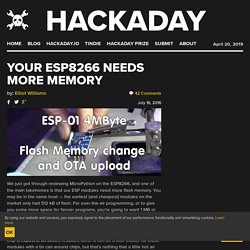
You may be in the same boat — the earliest (and cheapest) modules on the market only had 512 kB of flash. For over-the-air programming, or to give you some more space for fancier programs, you’re going to want 1 MB or even 4 MB. The solution? Just buy a new flash chip and solder it on. How to flash 16MB ESP8266. The ESP8266 chip is specified to support up to 16MB external SPI flash memory.
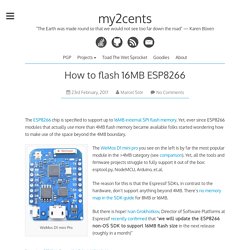
Yet, ever since ESP8266 modules that actually use more than 4MB flash memory became available folks started wondering how to make use of the space beyond the 4MB boundary. The WeMos D1 mini pro you see on the left is by far the most popular module in the >4MB category (see comparison). Yet, all the tools and firmware projects struggle to fully support it out of the box: esptool.py, NodeMCU, Arduino, et.al. The reason for this is that the Espressif SDKs, in contrast to the hardware, don’t support anything beyond 4MB. There’s no memory map in the SDK guide for 8MB or 16MB. Direct Pin access (set/clear/direction) - Everything ESP8266. - Sun Oct 05, 2014 8:52 pm#1256 Hello all, just for fun i digged a bit into IDA and eagle_soc.h, to see what registers are used to acces GPIO pins.
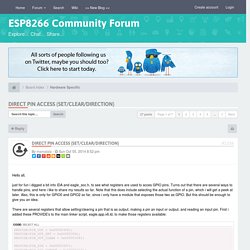
Turns out that there are several ways to handle pins, and here i like to share my results so far. Note that this does include selecting the actual function of a pin, which i will get a peek at later. Also, this is only for GPIO0 and GPIO2 so far, since i only have a module that exposes those two as GPIO. But this should be enough to give you an idea. Getting Started Guide - ESP8266. 1.1.
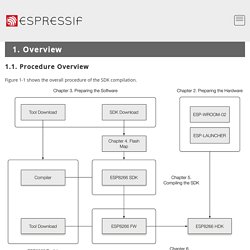
Procedure Overview Figure 1-1 shows the overall procedure of the SDK compilation. Figure 1-1 Procedure Overview The ESP8266 HDK (Hardware Development Kit) includes the chip —ESP8266EX, the module —ESP-WROOM-02 and the development board —ESP-LAUNCHER. Reference · ESP8266 Arduino Core. Table of Contents Pin numbers in Arduino correspond directly to the ESP8266 GPIO pin numbers. pinMode, digitalRead, and digitalWrite functions work as usual, so to read GPIO2, call digitalRead(2).
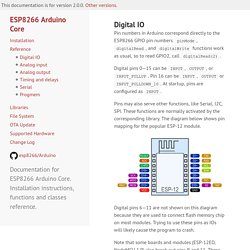
Digital pins 0—15 can be INPUT, OUTPUT, or INPUT_PULLUP. Pin 16 can be INPUT, OUTPUT or INPUT_PULLDOWN_16. At startup, pins are configured as INPUT. Pins may also serve other functions, like Serial, I2C, SPI. D1. Ian Sexton 2017 Introduction Specification The Board Wemos pins Using the Board Code In the beginning - Blink Testing the relay Fade the LED Test the switch Test the switch with interupts Another switch?
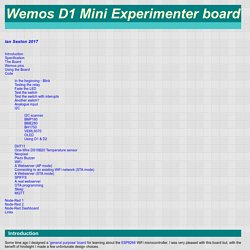
Analogue input I2C I2C scanner BMP180 BME280 BH1750 VEML6070 OLED Using D1 & D2. Tzapu/WiFiManager: ESP8266 WiFi Connection manager with web captive portal. Flash Download Tool - ESP8266 Developer Zone. Download ESP8266 Getting Started Guide EN下载 ESP8266 Getting Started Guide 中文版 UPDATE on 2016.11.14Download the latest Flash Download Tool.

UPDATE on 150916:1.fix the bug that tool does not show the MAC correctly for 48bit version of EFUSE.2.update MAC reading functions. D1 mini pro + i2c motor shield problems. Hi @ottojo , This is what I did...with the boards shipped to me, I found that the STM32 was not programmed (no i2c address when scanned) and could be flashed.

It sounds like you have also been shipped the the un-programmed ones, which is fortunate, as you just need to ensure the pin marked 'RTS' on the board (connected to boot0 on the STM32) is kept high to flash them. SMACCMPilot - osx. Most of the instructions for installing prerequisites and building should work on at least Linux and OS X, but assume that you’re well acquainted with your operating system’s package manager and other tools. Here are some hints that you may find helpful if you’re installing on a Mac. This codebase has been built using either MacPorts or Homebrew.
The following instructions are for MacPorts, though we’d welcome documentation contributions for other setups. Installing the ARM GCC Toolchain. GitHub - pbugalski/wemos_motor_shield: Alternative firmware for Wemos Motor Shield. Motor Shield Reprogramming. Turns out that the procedure in the previous log can be greatly simplified. You don't need an ST-Link programmer, and you don't need to solder anything. Even if your shield is locked, you can unlock and program it with a simple serial adapter. Here is how.
First, clone the repository: What is the I²C chip on this board? · Issue #1 · wemos/WEMOS_Motor_Shield_Arduino_Library. ESP8266 Reboot Cycled Caused by Flash Memory Corruption — Fixed! After I released the ESP8266-based OpenGarage, there has been a weird bug that kept bugging me: a small fraction of the controllers (let’s say 1 out of 10) would crash on restart, and that leads to an infinite reboot cycle. Once this happens, it seems there is no way to stop it until you reflash the controller with NodeMCU firmware, and then flash OpenGarage firmware back. For the longest time I thought there is a bug in the OpenGarage firmware code that causes this to happen. But the above symptom defies any standard reasoning and explanation.
D1 mini V2.1.0 solid blue light. I wouldn't throw it away just yet. The GPIO2 is also used as the TX pin of the second UART, which is used on boot to mirror the first UART and spew the diagnostics data. Since you see a continuous stream of that, it probably means that your ESP8266 got into a boot loop -- that is, it tries to boot its firmware, but then it instantly crashes, and the processor restarts and tries to boot again.
One possible reason for that happening is invalid data stored in the small memory that ESP8266 has reserved for storing things like its last restart reason or the name of the WiFi network to connect to. It is possible that this area of memory got corrupted either by noise on the power line of the chip, by shutting the power off at a wrong moment when that memory was being written to, or by some code that got executed on it and wrote its data in the wrong place. GitHub - esp8266/arduino-esp8266fs-plugin: Arduino plugin for uploading files to ESP8266 file system. GitHub - me-no-dev/EspExceptionDecoder: Exception Stack Trace Decoder for ESP8266.
GitHub - pulkin/esp8266-injection-example: A small project to demonstrate sniffer / packet injection capabilities of ESP8266 IC. Inject Packets with an ESP8266. [Kripthor] sent us a link to his blog where he writes the Hello World of low-level networking. Basically he’s constructing his own packet and sending it. By itself this isn’t a bad thing.
You could use this power for all sorts of networks-diagnostic good. And so, despite the ominous name of his blog post “ESP8266 Jamming”, he’s not really doing anything that bad — he’s just creating many fake WiFi beacon frames and sending them out every so often. Which can apparently do bad things to some vulnerable routers. Naturally we wanted to see how he was doing it, and we opened up the Arduino code in GitHub. Esp8266_reset_causes_and_common_fatal_exception_causes_en. I can't get SPI to work on WeMos D1.... : esp8266. WeMos Mini D1 - Default I2C & SPI pins. ESP8266EX Overview. Flashing the firmware - NodeMCU Documentation. Below you'll find all necessary information to flash a NodeMCU firmware binary to ESP8266 or ESP8285.
Note that this is a reference documentation and not a tutorial with fancy screen shots. Turn to your favorite search engine for those. Make sure you follow a recent tutorial rather than one that is several months old! ESP8266 Mini Sniff. I am constantly amazed at what the inexpensive ESP8266 can perform using only some creative software. In this article, I provide the Arduino sketch code to morph the WiFi device into a promiscuous WiFi scanner that will display both client and AP MAC addresses, broadcasts, signal strength and channel.
It is a great project that listens silently to the WiFi 2.4G band looking for activity and then displaying it over the serial port. Arduino Tutorial: ESP8266 OTA. Update the WeMOS D1 Over the Air (OTA). - educ8s.tv - Watch Learn Build. Jeija/esp32free80211: Send arbitrary IEEE 802.11 frames with Espressif's ESP32. ESP32’s Wi-Fi Range Extended to 10 km with a Directional Antenna. ESP32 Security Bug Bounty Program Launched. Developers’ Essential Information - ESP8266 Developer Zone. ESP8266 12E - How to upgrade to latest firmware - ESP8266 Developer Zone. Update the Firmware in Your ESP8266 Wi-Fi Module. Objective and Rationale This is the author's second article about the ESP8266 integrated circuit, a relatively new chip comprising a full-featured 32-bit RISC µC and a built-in 802.11 b/g/n Wi-Fi circuit.
The first article described using the Arduino IDE to program the ESP8266, and contains some important background information that will not be repeated here. If you haven't read it, please do. There is no shortage of information on the Web about the 8266; in fact, there may be too much...of the wrong type. The developers of the IC, Espressif, have apparently chosen to not only outsource manufacturing, but also to avoid being directly involved in the line of ESP modules that utilize the ESP8266 chip.
ESP modules are available from a variety of sources, and the firmware contained in the ESP8266 chips on the modules is almost always outdated and often of questionable origin. Hardware Setup PuTTY Terminal Program Open PuTTY, and click the Serial radio button. Internet of Home Things » 4 ways to eliminate ESP8266 resets. WEMOS ESP8266 D1 (Arduino sized) board - problems! - Everything ESP8266. Wemos d1 mini pin mapping · Issue #1243 · esp8266/Arduino.
_gpio_pin_allocations [ESP8266 Support WIKI] PinMode(), digitalRead(), digitalWrite(), analogWrite() work as usual. ESP8266 Thing Hookup Guide. Arduino/reference.md at master · esp8266/Arduino. Advanced Arduino – Including Multiple Libraries In Your Project. SPIFFS file read and write example. WeMos.cc. ESP8266 Thing Hookup Guide. Start [ESP8266 Support WIKI]